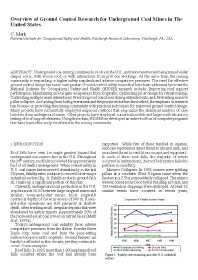Mining Publication: Overview of Ground Control Research for Underground Coal Mines in the United States
Original creation date: June 2001
Underground coal mining continues to evolve in the U.S., and more reserves are being mined under deeper cover, with worse roof, or with interactions from previous workings. At the same time, the mining community is responding to higher safety standards and intense competitive pressures. The need for effective ground control design has never been greater. Ground control safety issues that have been addressed by recent the National Institute for Occupational Safety and Health (NIOSH) research include: Improving roof support performance; Maintaining safe tailgate escapeways from longwalls; Optimizing pillar design for retreat mining; Controlling multiple seam interactions; Predicting roof conditions during extended cuts, and; Preventing massive pillar collapses. As funding from both government and the private sector has diminished, the emphasis in research has focused on providing the mining community with practical techniques for improved ground control design. Many projects have successfully employed empirical methods that emphasize the statistical analysis of case histories from underground mines. Other projects have employed numerical models and large-scale laboratory testing of roof support elements. Using these data, NIOSH has developed an entire toolbox of computer programs that have been effectively transferred to the mining community.
Authors: C Mark
Conference Paper - June 2001
NIOSHTIC2 Number: 20021380
Proc 17th Intl Mining Congress and Exhibition of Turkey (IMCET 2001) (June 19-22, Ankara, Turkey), 2001; :3-10
See Also
- Refuge Alternatives in Underground Coal Mines
- Roof Screening for Underground Coal Mines: Recent Developments
- Safe and Economical Inerting of Sealed Mine Areas
- SPONCOM - A Computer Program for the Prediction of the Spontaneous Combustion Potential of an Underground Coal Mine
- The Status of Mine Fire Research in the United States
- Technology News 526 - Proceedings of the International Workshop on Rock Mass Classification in Underground Mining
- Ultra-Low Frequency Through-the-Earth Communication Technology
- Underground Coal Mining Disasters and Fatalities: United States, 1900-2006
- Variation of Horizontal Stresses and Strains in Mines in Bedded Deposits in the Eastern and Midwestern United States
- Wireless Mesh Mine Communication System
- Page last reviewed: 9/21/2012
- Page last updated: 9/21/2012
- Content source: National Institute for Occupational Safety and Health, Mining Program


 ShareCompartir
ShareCompartir
